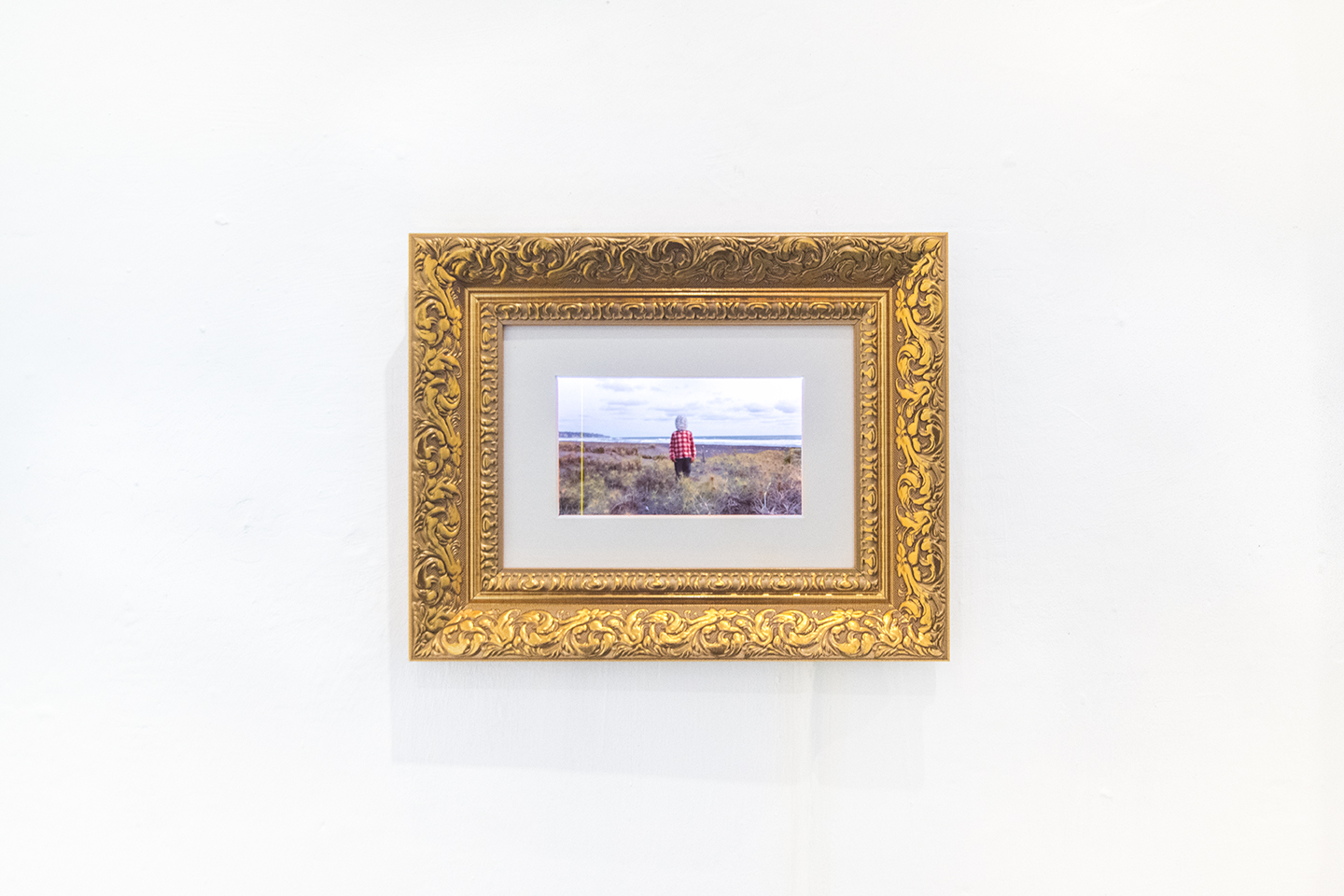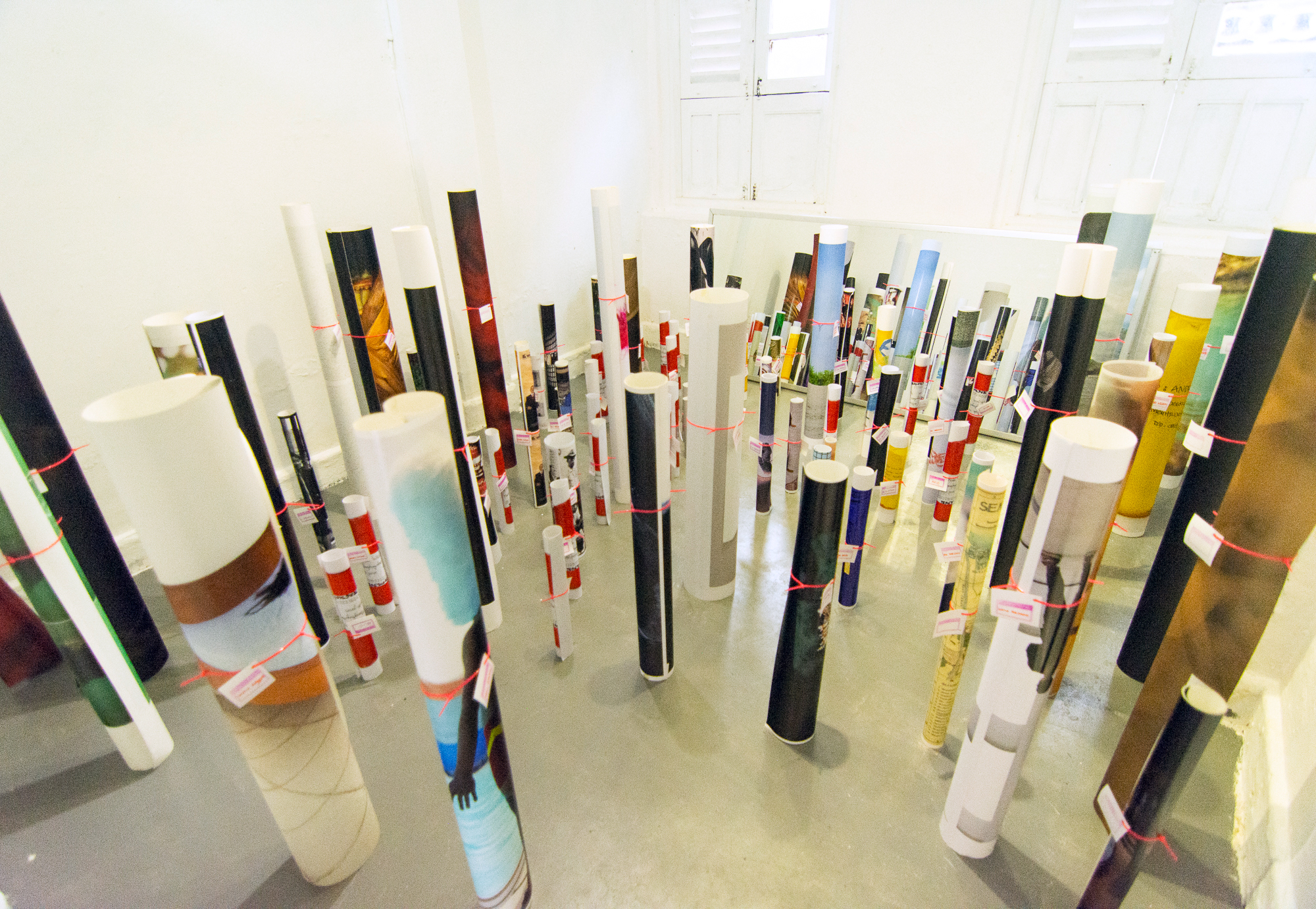. Courtesy of the Artists .
COURTESY OF THE ARTISTS
pameran tunggal oleh Akiq AW
Lir Space, Yogyakarta
March 2019
______________________________
“So
why should so many talented and hyper-qualified artists submit
themselves willingly to a field of work (that is, in art) that offers so
little in return for such a huge amount of remunerated labor?” [i]
I.
Mungkin hanya di
masa kejayaan peradaban kuno, di negara-negara kaya, dan di kerajaannya Raden
Mandasia saja seorang seniman dibayar untuk melamun dan melakukan proses
kekaryaan. Proses dalam hal ini merujuk pada hal-hal di antara ketiadaan,
inspirasi, riset, produksi, sampai karya seni dihasilkan dan memiliki potensi
mendatangkan keindahan atau perubahan sosial.
Di Estonia,
misalnya, seorang seniman diberikan gaji bulanan, asuransi, dan rencana pensiun
yang nyata supaya kebutuhan dasarnya terpenuhi sehingga seniman tersebut bisa
fokus berkarya saja. Belanda pernah menjadi negara yang memberikan subsidi
besar-besaran untuk senimannya supaya mereka bisa berkarya—tetap dibayar saat
melamun di studio, mencoba formula karya baru yang mungkin berhasil mungkin
tidak, dan nongkrong dengan teman untuk saling berbagi pengetahuan atau sekedar
bergosip dan berbagi info peluang. Subsidi ini dipotong besar-besaran saat
pemerintahan sayap kanan membentuk kebencian publik dengan menunjukkan
bagaimana uang pajak mereka digunakan, misalnya saat pembukaan pameran yang
didatangi oleh para kaum elit dengan gelas anggur merah yang tidak pernah
kosong di tangan mereka—hal ini dengan tidak sensitif dilakukan di
gedung-gedung bersubsidi tempat para imigran dan kaum miskin yang lebih
membutuhkan tunjangan kehidupan hanya mendapat sisa-sisa pajak pesta pora seni
rupa yang disebut pemerintah sebagai ‘leftist hobby’, hobi orang-orang kiri.
Tentu saja
kemewahan ini tidak serta merta dinikmati oleh seniman banyak negara maju lain,
meskipun peluang untuk mendapatkan dana hibah cukup tinggi, namun subsidi
seniman masih merupakan hal yang tidak biasa. Seniman-seniman negara maju yang
kebingungan atau tidak terbiasa dengan ketidakpastian berbondong-bondong belajar
dari negara-negara yang senimannya tidak mendapatkan subsidi pemerintah. Rumput
yang satu terlihat lebih hijau dari rumput lainnya.
Boro-boro subsidi
pemerintah, struktur seninya saja belum ‘mapan’ (dalam ukuran standar Barat)
meskipun bukan berarti tidak ada—bahkan kebanyakan sudah berjalan
bertahun-tahun. Hal ini justru membentuk sesuatu yang disebut oleh kurator Zoe
Butt sebagai ‘ecology of cultural lack’ [ii] Absennya negara
dan pendanaan luar, amnesia sejarah, kekangan atas kebebasan berpendapat, dan
faktor lainnya menjadikan hubungan pertemanan dan praktek berkumpul menjadi
lebih dari sekedar sistem penyokong untuk berkesenian namun juga strategi untuk
bertahan hidup. Struktur kesenian terbentuk secara organik dan tumbuh subur
terus menerus membentuk ekologi liar tanpa aturan yang jelas. Namun di waktu
yang sama, kebebasan dan kemungkinan yang ada dalam dunia seni tanpa struktur
ini sungguh tidak terbatas: bisa membuat pameran tentang apa saja, di mana
saja, kritik terhadap pemerintah bisa dilakukan (apalagi jika negara tidak
memberimu makan) dan apapun latar belakang pendidikanmu—kesempatan menjadi
seniman tidak terbatas! Pertukaran moneter berubah menjadi nilai tukar yang
berbeda: pertemanan, solidaritas, kesamaan nilai-nilai, dan kemajuan bersama
sebuah skena. Skena yang menjadi begitu romantis, meskipun dalam kondisi lapar.
Bagaimanapun juga, bukan kah urusan perut lah yang menjadikan tulisan Orwell begitu menggugah, begitu pula Hemingway yang diam-diam menjerat kepala burung dara malang di taman-taman untuk memberi makan keluarganya di rumah—sebuah usaha untuk menyelesaikan masalah perut sambil berproses mencari inspirasi karya tulis berikutnya. Sebuah kutukan Cina kuno “May you live in an interesting time” berubah menjadi berkah. Jika seniman tersebut hidup dalam masa-masa yang ‘menarik’, penuh tekanan sistem, dan memiliki musuh bersama untuk dilawan; kelompok-kelompok seni tersebut setidaknya bisa menghasilkan karya-karya yang tak kalah menarik, kritis, politis, signifikan, revolusioner.
_______________
“The art field is
a space of wild contradiction and phenomenal exploitation. It is a place of
mongering, speculation, financial engineering, and massive crooked,
manipulation. But it is also a site of commonality, movement, energy, and
desire” [iii]
II.
Membicarakan
kerja-kerja artistik seorang, sangat mungkin kita secara tidak langsung harus
menyertakan kerja-kerja non-artistiknya; Akiq AW memilih untuk membangun usaha
rumahan bernama Juwara. Sebuah perusahaan yang berfokus pada cetak digital.
Melihat kerja-kerja harian Akiq bersama Juwara tidak lantas sesederhana
bagaimana seorang pekerja memenuhi kebutuhan finansialnya saja. Dalam kerja-kerja
hariannya, ia cukup dipengaruhi gagasannya tentang membangun ekosistem yang
tumbuh bersama. Jasa cetak digital yang dirintisnya secara langsung maupun
tidak langsung digerakkan oleh sesama seniman, atau orang-orang dari lingkungan
kesenian. Juwara tidak berhenti pada produksi fisik karya seni saja namun juga
memberikan peluang kerja serta sistem yang cair dan kekeluargaan. Pertukaran
yang terjadi tidak semata-mata hanya persoalan pertukaran cetakan foto dan uang
saja. Pertukaran-pertukan immaterial, negosiasi-negosiasi yang berlandaskan
pertemanan pun terjadi. Juwara tidak saja menjadi strategi bertahan dalam
memenuhi kebutuhan kesehariannya namun juga memenuhi hasratnya untuk
berkontribusi pada skena seni rupa khususnya dalam mensiasati produksi-produksi
karya seni berbasis cetak digital. Sistem yang saling menguntungkan bagi
seluruh pihak ini merupakan salah satu cara bekerja bersama untuk membentuk
taktik bertahan hidup dalam struktur ekonomi seni yang terstruktur/tidak
terstruktur.
Dalam
dua ruang yang berada di sisi utara Lir Space, Akiq AW menghadirkan Juwara
dalam wujud sekumpulan test print. Dalam ruangan pertama, ia telah memilih
beberapa test print yang dianggap tidak sempurna namun memiliki ukuran yang
sebenarnya, yang kemudian ia susun rapi dalam bentuk gulungan. Para pemilik sah
(pemesan – klien) dipersilakan untuk mengambil gulungan-gulungan foto tersebut.
Secara sekilas, aksi ini dapat dilihat sebagai sesuatu yang sederhana seperti
mengosongkan studio dari tumpukan test print tersebut namun di saat yang sama,
tumpukan test print tersebut adalah sekumpulan arsip, yang secara langsung
maupun tidak langsung membentuk kepekaan dan craftsmanship Akiq
baik sebagai juru cetak maupun seorang seniman. Ketika kesadaran dalam melihat
tumpukan test print ini berubah, pengembalian yang dilakukan dalam pameran pun
tidak lagi menjadi aksi pembersihan gudang semata, arsip-arsip ini kemudian
dilihat oleh publik yang lebih luas, yang kemudian sangat mungkin untuk
bergerak lebih jauh dari sekedar dipertontonkan.
Seperti
halnya arsip yang perlu bergerak untuk berfungsi, sisa produksi pun perlu
digerakkan untuk kembali memiliki nilai. Kesadaran menggerakan arsip bersama
publik yang baru terlihat pada ruang berikutnya dimana sekumpulan test print
ini dipajang secara masif di dinding-dinding ruang tersebut. Gagasan untuk
mempertemukan arsip ini dengan khalayak yang baru, serta melibatkannya ke dalam
pengelolaan arsip ini (walaupun sifatnya sementara) terlihat jelas. Akiq
mengundang dua kelompok seniman muda untuk terlibat dalam pemajangan seluruh
test print ini, yang kemudian hal ini tidak saja membagi pengetahuan perihal
bentuk-bentuk kekaryaan medium fotografi namun juga dalam wilayah pengalaman
kerja-kerja pemajangan yang merupakan salah satu hal yang cukup penting diketahui
dan dialami oleh seniman, khususnya seniman muda. Pertukaran antara pemajangan
yang dilakukan oleh dua kelompok seniman muda ini dengan Akiq adalah pertukaran
yang sangat fleksibel dan tidak berbasis nilai-nilai ekonomi yang standar.
Kerja-kerja pemajangan yang ditukar dengan pengetahuan, pengalaman, serta
beberapa gelas es kopi susu ataupun makan siang dan malam menjadi nilai-nilai
yang disepakati diantara mereka. Nilai-nilai pertemanan dan kepercayaan yang
menjadi modal dasar pertukaran semacam ini mungkin memang belum menjawab
persoalan pemenuhan kebutuhan harian tiap-tiap individu yang terlibat di
dalamnya namun setidaknya telah mampu menggerakkan kehidupan kesenian secara
terus-menerus ketika nilai-nilai ekonomi yang digadang-gadang sebagai jawaban
atas permasalahan-permasalahan kesenian tidak segera menampakan dirinya.
_______________
“Neighborhood currencies appear, not only in places like Greeces, to keep goods and services moving when the money system breaks down. The currency could be a stone or a handshake – it doesn’t matter and doesn’t even have to be material when it’s backed by bons of trust, by family love, or by friendship. All that is capital melts into love” [iv]
_______________
"... Individuals as determinants of minor currents, must not be swallowed anonymously into many (people), who are major. The major influential against the minor, but the major will never be necessary if the minor as the determining subject is absent. How do you see yourself in a pluralistic crowd entity? The generic one? Generally? Are you still there?" [v]
(Pablo Helguera-2009)
III.
Kecenderungan untuk berkumpul, dan kemudian
menyebut diri sebagai satu kelompok – atau yang kini lebih akrab dengan sebutan
kolektif – memang menjadi salah satu hal yang cukup umum, khususnya ketika
berada di titik awal sebuah perjalanan karir (dalam hal ini karir seorang
seniman). Diantara banyaknya perbedaan dalam pengertian berkumpul dan
berkelompok antar generasi, setidaknya ada satu hal yang tak berubah meski
jaman – rezim pemerintah telah berubah, yaitu kelompok selalu menjadi ruang
untuk membagi pengetahuan dan pengalaman. Arus pertukaran pengetahuan dan
pengalaman ini kemudian secara langsung atau tidak langsung mempengaruhi
penciptaan seseorang di dalamnya.
Berada di dalam kelompok memang menjadi
kecenderungan yang umum dan kerap dilihat sebagai keuntungan (khususnya dengan
kemungkinan terjadinya arus pertukaran pengetahuan yang cukup kencang) namun di
saat yang sama, pertanyaan-pertanyaan seperti “Bagaimana
seseorang melihat dirinya di tengah entitas keramaian yang plural?” atau
“Apakah seorang individu masih mungkin terlihat diantara kerumunan?”[vi] selalu mengikuti.
Pertanyaan ini hadir bukan dalam mempertandingkan antara gagasan menjadi
individual atau kelompok. Ia hadir dalam wujud yang reflektif, yang di akhir
hari bisa jadi justru ia memberikan kekuatan sendiri pada kedua keputusan
tersebut, baik menjadi individual maupun kelompok.
Akiq AW, yang sudah berada di
dalam kelompok sejak 17 tahun yang lalu tentu mengalami masa-masa bulan madu
maupun masa-masa penuh perjuangan di dalam kelompok.
Meski tidak pernah
dimaksudkan untuk menjawab kedua pertanyaan diatas namun melihat karya Akiq AW
yang berjudul Parasite Art Project adalah cara yang menarik bagaimana
merefleksikan pertanyaan-pertanyaan tersebut. Dimulai dari mengenali dan
memperlihatkan kerja-kerja individual di dalam kelompok dimana ia berada, di
saat yang sama ia pun memperlihatkan dirinya, cara kerja dirinya atas
individu-individu di sekitarnya. Di saat yang sama, ia pun memperlihatkan
bagaimana pengetahuan (dalam hal ini penciptaan karya yang biasanya
diasosiasikan dengan modal intelektual) disebarkan, dibagikan, hanya dengan
ikatan kepercayaan dan kedekatan. Tentu saja tidak semuanya seromantis hubungan
pertemanan di film Mengejar Matahari. Resiko dalam pola kerja semacam ini
adalah eksploitasi, baik pada diri sendiri maupun pada pihak-pihak lain. Namun
jika seluruh pihak menyetujui dan sama-sama suka, bukan kah tidak apa-apa?
Bagaimanapun juga, seluruhnya kembali pada: cinta. Perasaan abstrak yang
membuatmu rela melakukan banyak hal yang tidak masuk akal.
.en.
i Julietta Aranda, Brian Kuan Wood, Anton Vidokle. “Introduction”. Are You Working Too Much? Post-Fordism, Precarity, and the Labor of Art”. Hal.6 | Sternberg Press. 2011.
ii Zoe Butt. "Practicing Friendship: Respecting Time as a Curator." Practicing Friendship: Respecting Time as a Curator | Asia Art Archive. Asia Art Archive, 22 Nov. 2015. https://aaa.org.hk/en/ideas/ideas/practicing-friendship-respecting-time-as-a-curator. Maret 9. 2019.
iii Hito Steyerl. “Politics of Art: Contemporary Art and the Transition to Post-Democracy”. Are You Working Too Much? Post-Fordism, Precarity, and the Labor of Art”. Hal.36 | Sternberg Press. 2011.
iv Brian Kuan Wood. “Is It Love?”. What’s Love (or Care, Intimacy, Warmth, Affection) Got to Do with It?. Hal.18 | Sternberg Press. 2017.
v Suka Hardjana. “Falsafah Sapulidi Membaca Kembali Manusia Indonesia: Defisit Individu dalam Kerumunan Massa Politik Gotong Royong”. | Titik Balik, 20 Okt. 2015 | http://www.titikbalik.co/2015/10/falsafah-sapulidi-membaca-kembali.html. Maret 9. 2019.
vi idem












